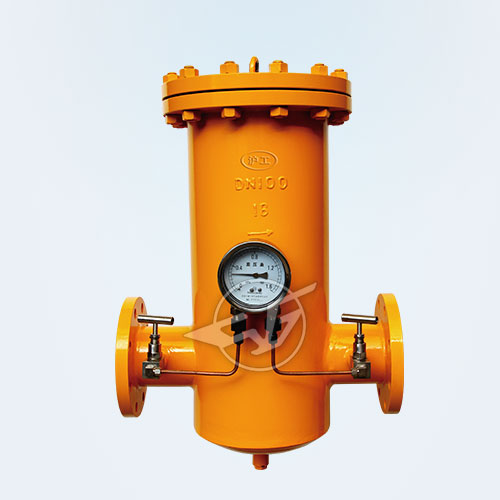Natural gas filter

The natural gas filter is mainly composed of a cyclone separator, two-stage inertia demister pre-filtration and coagulation, three-stage fine filter core coagulation, and a sewerage valve. The natural gas entrained with liquid and solid particles enters the tangent direction from the intake pipe. Cyclone separator.
working principle
The natural gas first enters the feed gas chamber, and the gas first hits the support tube supporting the filter element (to avoid direct air flow hitting the filter element, causing premature damage of the filter material). The larger solid-liquid particles are initially separated and under the action of gravity. Settling to the bottom of the container (regularly drained from the drain outlet). Then the gas passes through the coalescing filter element from the outside to the inside, the solid particles are retained by the filter medium, and the liquid particles gradually agglomerate on the inner surface of the filter element due to the coalescence function of the filter medium (as shown in the figure below). When the droplet reaches a certain size, it will fall off from the inner surface due to the impact of the air flow, enter the inner flow channel of the filter element, and then enter the sink material cavity. In the sink effluent chamber, the larger droplets are separated by gravity sedimentation. In addition, in the sink effluent chamber, separation elements are provided to effectively trap the droplets to prevent entrainment of the outlet droplets. Further improve the separation effect. The last clean gas flows out of the filter separator. With the increase of the gas throughput, the particles deposited on the filter element will cause the pressure difference of the gas filter to increase. When the pressure difference rises to the specified value (read out from the differential pressure meter), the filter element has been seriously blocked and should be timely. replace. The initial pressure difference of the filter separator is not higher than 20KPa, and the exchange pressure difference is not higher than 100KPa.
Common faults and handling
1) Flange or quick opening blinds leak
During the running or boosting process, the soap solution method was used to check the leak. When the leak was discovered, the process must be switched immediately, the accident separator was stopped, and the blowdown operation was performed. After the pressure dropped to zero, the maintenance operation was performed.
2) The pressure difference before and after the separator increases or the flow decreases
During operation, due to the increase of natural gas impurities or more solid particles, the pressure difference before and after the separator is increased. When it exceeds 0.1 MPa, it indicates that there is a blockage inside the filter, and the filter element should be stopped and replaced in time. If more than 2 separators are running at the same time, when the flow rate of the flowmeter after a filter separator is 30% smaller than the other channels (this set value can be adjusted during operation), this indicates that the filter separator may be Plugged, need to repair or replace the filter element.


 No.31011802002466
No.31011802002466

